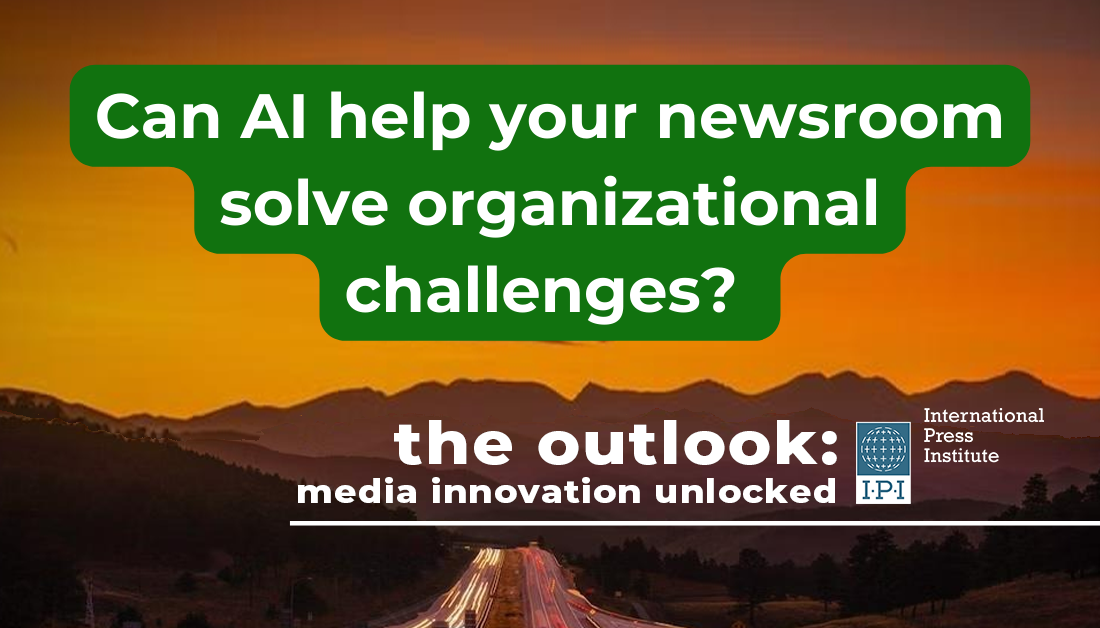This text comes from IPI’s newsletter The Outlook. Click here to sign up to receive future editions direct to your inbox.
In this edition of The Outlook, IPI’s media innovation newsletter, we’re thinking about how news organizations can harness the power of AI to support their journalism – and when to pause, reflect and learn.
The challenge: There’s a risk of getting left behind – or distracted
There are already many inspiring examples of how AI has helped improve journalistic processes.
Algorithms can ‘read’ and detect patterns in enormous datasets to assist with investigations, and can be trained to perform fact checks. Future products could see chatbots that discuss news articles with readers, acting as ‘news therapists’ and counteracting news avoidance. The most recent advances, with generative AI and large language models, widen the possibilities even further.
As Charlie Beckett told IPI’s World Congress earlier this year: “AI is not going away. At the very least, journalists need to understand it so they can understand the world they’re reporting on.”
But in terms of actually using it, how can a news organization – especially those with smaller teams – get started and ensure their core ideas don’t get lost in the process?
Along with the risk of being left behind by a new technological shift comes the risk that pursuing it relentlessly will lead you away from who you are. Before diving in, make sure you consider how AI would fit into your workflows and support organizational goals, and let your audience know what you’re doing.
The solution: Be curious, but strategic about AI
The first step is to slow down. The angle should not be ‘how can we use AI?’ – it’s about considering AI as part of the solution to existing questions your organization has. A design thinking approach (define, ideate, prototype, test) is a useful structure.
During IPI’s Transition Accelerator, Ukrainian independent radio Hromadske Radio worked on experiments using AI to reach new audiences and improve workflows. This included translating their Ukrainian news into English for their growing international audience, and using text-to-audio tools to create podcasts.
Hromadske Radio carried out rounds of testing and experimenting before they reached a product they were happy with. AI provided a great solution to their challenge of reaching an English-speaking audience and increasing reach by bringing their audio content to smart speakers. Here’s how that process might look for you.
Define: Clarify your goals first, for example, speeding up content production, improving representation of specific demographics in your articles, including wider sets of data in your investigations, or reaching a specific new audience.
Ideate: Think of possible solutions. These could include using AI, for example:
- Experiment with using a generative AI tool to brainstorm headlines or social media captions for inspiration, to add a new perspective
- Explore tools like transcription or text-to-speech to produce more content in formats you think will appeal to this audience
- Create AI-generated summaries to use across different social media platforms
Choose one, or a few, of your ideas to test, based on those that are the highest impact and lowest risk.
You might find that the ideas that best fit those criteria don’t include AI at all. But the exercise of breaking down your problem and considering how AI could help, could also spark ideas for improvements to your human-centered processes.
Prototype: You’ll only be able to prototype an AI-based solution if you already have the relevant data. For experiments like text-to-audio or generated summaries, your articles are the data, but for a product like personalized recommendations, you would need data on user behavior and demographics.
When starting out with AI, you’ll most likely want to use pre-trained models or existing tools, such as text-to-audio, audio-to-text or translation tools, rather than building a solution from scratch.
Test: Once the prototype is ready, it’s time to test. Don’t forget to add in that human element of editing and judgment before you evaluate whether this solution is worth sticking with.
The Takeaway: You may not need an AI strategy, but do think about where AI could fit into other parts of your content, audience or business strategy.
There are plenty of resources out there to help you get started: Browse Partnership on AI’s database of AI tools local newsrooms can use; try the Starter Pack from the JournalismAI team at Polis, LSE; or take inspiration from this list of 11 simple ways one freelance journalist is using ChatGPT to aid her work.
News from IPI’s Media Sustainability Team
Hailing from Ecuador to Zimbabwe, Indonesia to Yemen, 12 local news organizations have joined IPI’s Local News Accelerator to develop the skills they need to fill information gaps in their communities and build strong business models. Over the next three months, we are excited to work with these teams and we’ll be sharing the lessons we learn together in this newsletter and on the IPI website.
And from October 19th, we are kicking off IPI’s New Media Incubator bootcamp, bringing together 10 early-stage newsrooms from across Europe for a few days of intensive training at IPI’s Vienna headquarters. We’ll be sharing snippets of their journey on our Twitter and Instagram if you’re curious to see what we get up to.
We’d also like to celebrate the team behind Lazy Women, the international organization which participated in IPI’s Transition Accelerator. Lazy Women is a diverse platform and community aiming to challenge concepts of femininity and womanhood. They’ve now taken the plunge and launched the Lazy Revolution, a crowdfunding campaign to support their financial sustainability.
Funding opportunities for media
- Free Press Unlimited have two open calls at the moment that could be interesting to newsletter readers. First, there’s a call for media organizations that are based anywhere in the EU, with a preference for Central and Eastern Europe, and have a track record of collaborative and investigative journalism. The goal is to build three regional media hubs as part of the Collaborative and Investigative Journalism Initiative: read more about what they’re looking for here.
- Free Press Unlimited are also offering a €20,000 grant to three organizations in the MENA region, which is to help them integrate fact-checking into their workflow. The grant is to cover the secondment of a fact-checker to successful organizations as well as capacity-building and operational support; read more and apply here.
- Indigenous journalists in Brazil are invited to apply to Agência Pública’s Indigenous Reporters Training Program offering a BRL8,000 grant and training in order to improve investigative journalism skills and develop a story based on threats to indigenous populations.
- Journalists (and student journalists) who have written about labour migration issues may be eligible to enter the International Labour Organization (ILO)’s Global Media Competition. Prizes are up to $1,200 and entries can be in any format, but must be either written in English, French, Spanish or include a translation.
- Finally, it’s free to attend the Donbas Media Forum which was set up to bring together independent media from across Ukraine. The application form (in Ukrainian) is here.
IPI’s media innovation and sustainability work is made possible with support from the European Union, Friedrich Naumann Foundation and ERSTE Foundation.




